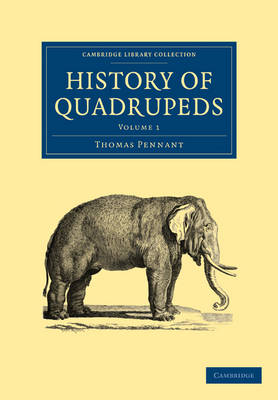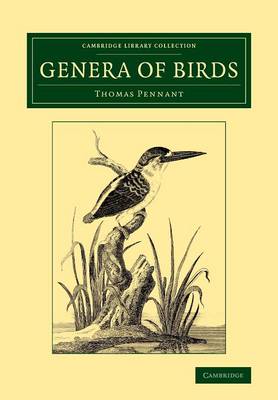Cambridge Library Collection - Zoology
3 primary works • 6 total works
Volume 1
Thomas Pennant (1726–98) was a keen geologist, naturalist and antiquary. Linnaeus supported his election to the Royal Swedish Society of Sciences in 1757, and in 1767 he became a Fellow of the Royal Society. His History of Quadrupeds (1793), aimed to promote natural history among a wider readership, originated in an informal index to John Ray's Synopsis of 1693. In his preface, Pennant acknowledges the monumental Histoire naturelle by the Comte de Buffon, as well as works by Klein (1751), Brisson (1756), and particularly the work of Linnaeus, though Pennant strongly disagreed with Linnaueus's classification of primates as including humans with apes. Pennant's two-volume book, beautifully illustrated with over 100 engravings, provides an overview of the state of zoological classification at the end of the eighteenth century. Charles Darwin owned a copy and had it sent to him in South America during the Beagle voyage.
Volume 1
In the 'Advertisement' to this 1784 two-volume work, Thomas Pennant (1726–98), zoologist and traveller, explains that his original intention was to record the zoology of North America 'when the empire of Great Britain was entire'. After the War of Independence, he changed his focus to the zoology (and people, archaeology and geology) of the Arctic regions of America, Europe and Siberia. The content of the volumes, one of the earliest works of systematic zoology published in Britain, is based on the writings of earlier zoologists, information obtained by Pennant from his scientific correspondents all over Europe and America, and his studies in private museums and collections. It is embellished with engravings of animals, birds, landscapes and artefacts. Volume 2 deals with land and water birds, including some, such as the passenger pigeon, which are now extinct. Other works by Thomas Pennant are also reissued in the Cambridge Library Collection.
Volume 2
Thomas Pennant (1726–98) was a keen geologist, naturalist and antiquary. Linnaeus supported his election to the Royal Swedish Society of Sciences in 1757, and in 1767 he became a Fellow of the Royal Society. His History of Quadrupeds (1793), aimed to promote natural history among a wider readership, originated in an informal index to John Ray's Synopsis of 1693. In his preface, Pennant acknowledges the monumental Histoire naturelle by the Comte de Buffon, as well as works by Klein (1751), Brisson (1756), and particularly the work of Linnaeus, though Pennant strongly disagreed with Linnaueus's classification of primates as including humans with apes. Pennant's two-volume book, beautifully illustrated with over 100 engravings, provides an overview of the state of zoological classification at the end of the eighteenth century. Charles Darwin owned a copy and had it sent to him in South America during the Beagle voyage.
Thomas Pennant (1726-98) was a keen geologist, naturalist and antiquary. Linnaeus supported his election to the Royal Swedish Society of Sciences in 1757, and in 1767 he became a Fellow of the Royal Society. His History of Quadrupeds (1793), aimed to promote natural history among a wider readership, originated in an informal index to John Ray's Synopsis of 1693. In his preface, Pennant acknowledges the monumental Histoire naturelle by the Comte de Buffon, as well as works by Klein (1751), Brisson (1756), and particularly the work of Linnaeus, though Pennant strongly disagreed with Linnaueus's classification of primates as including humans with apes. Pennant's two-volume book, beautifully illustrated with over 100 engravings, provides an overview of the state of zoological classification at the end of the eighteenth century. Charles Darwin owned a copy and had it sent to him in South America during the Beagle voyage.
The naturalist and traveller Thomas Pennant (1726–98) helped popularise British ornithology by meticulously compiling and arranging existing research. At the age of twelve, Pennant had been given Francis Willughby's Ornithology (1678), to which he credited his lifelong love of natural history. His own writings on ornithology are heavily based on the classification system devised by Willughby and John Ray, which divides birds primarily into land birds and waterfowl. Although Pennant's brief, accessible book brought few original insights to the field, it boosted public interest in the study and classification of birds. The detailed descriptions of the appearance and habits of each bird are enlivened by the author's elegant turns of phrase. This better-known 1781 version of the 1773 original includes fifteen fine engravings. Pennant's other zoological works include Arctic Zoology (1784–5) and his History of Quadrupeds (third edition, 1793), both of which are reissued in this series.
In the 'Advertisement' to this 1784 two-volume work, Thomas Pennant (1726-98), zoologist and traveller, explains that his original intention was to record the zoology of North America 'when the empire of Great Britain was entire'. After the War of Independence, he changed his focus to the zoology (and people, archaeology and geology) of the Arctic regions of America, Europe and Siberia. The content of the volumes, one of the earliest works of systematic zoology published in Britain, is based on the writings of earlier zoologists, information obtained by Pennant from his scientific correspondents all over Europe and America, and his studies in private museums and collections. It is embellished with engravings of animals, birds, landscapes and artefacts. Volume 1 describes the various habitats of the Arctic, and the quadrupeds found there; Volume 2 focuses on birds. Other works by Thomas Pennant are also reissued in the Cambridge Library Collection.


